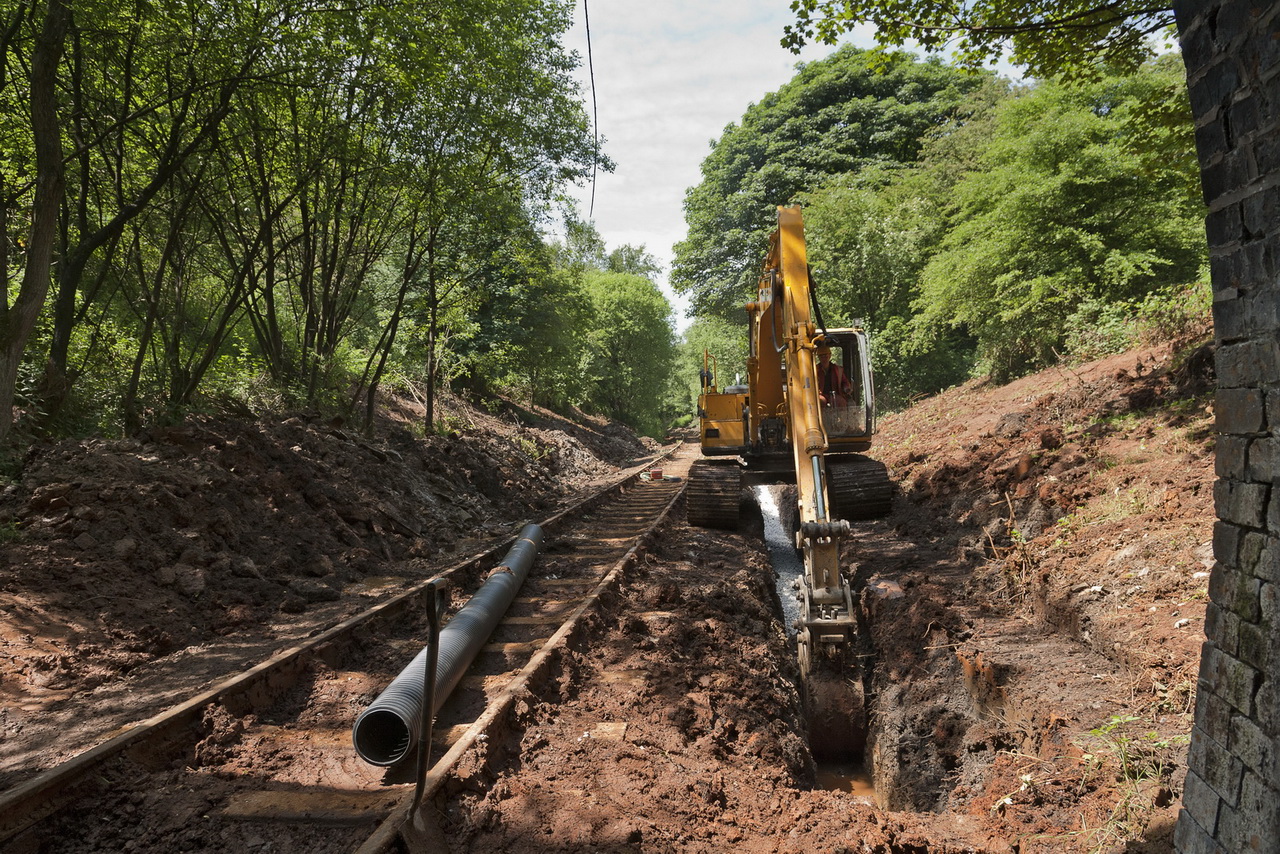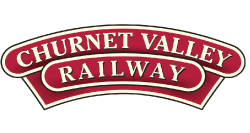Celebrating 10 years of the reopening of the Cauldon Lowe Branch - 3rd October 2020
On the 3rd October 2010 at around 1700, the Churnet Valley Railway (CVR) made preservation history in North Staffordshire by operating the first steam hauled train to cross over Leekbrook Junction and turn right onto the steeply graded Cauldon Lowe line. With little fuss and fanfare LMS 8f 2-8-0 No. 8624 powered over the junction and for the first time in its preservation history tackled a gradient with a moderately heavy train. With the rails still covered in over 20 years of accumulated rust and coupled with tight curves the trailing load including a Class 37 No. 37075 made a change to what 8624 had been used to pulling.
I was on the footplate for this historic run with former Stoke (5D) fireman Frank Dale, Chris Meadowcroft and John Peake. Typical of the humour of Frank, when we crossed over no. 16 points he looked over to me and asked ‘what was I doing open the bloody thing up ! ‘despite all the training we had done in the months leading up to this, this was the very first training trip on a steam locomotive, driving a diesel up the branch could simply not match the shear power of a steam locomotive.
So how did we find ourselves in the position of even getting to driving a steam locomotive up the branch ? This started back in 2008 when I partnered with David Kemp a former CVR Director, to purchase the branch line from Network Rail. Various failed attempts by previous CVR management came to nothing. On the 31st March 2009, David and myself were to be found in the offices of Martineau Solicitors in Birmingham to sign a 150 years lease between Moorland & City Railways and Network Rail. At some point after 1500 on that day, the money left our account and was sent to Network Rail. We now effectively owned the railway.
A series of meetings ensued with relevant parties to attempt to start the process of getting freight traffic back on track, for various reasons too numerous to recount in this article this did not happen quite as planned, however from this was born the idea of reopening the railway for use by the Churnet Valley Railway.
So on the 10th May 2010 at 14:07 , Bradshaw’s a rail contractor commenced clearing the tracks. At this early stage, no plans had been formulated on how to celebrate the opening of the line or more importantly when would the line open. We simply had no comparisons.
Progress at first was slow, however over the ensuing months step by step we started to see light at the end of the tunnel. At this stage this was just a clearance exercise, we still had not been able to properly assess the infrastructure. As first stage clearance was completed, the purpose of which was to create a corridor for plant to go up and down allowing a thorough inspection to take place. We found ourselves with 8.01 miles of decent railway albeit the sleepers had not survived quite so well and the drainage had failed in numerous locations.
Many meetings later, we felt we stood a chance to reopen the line in a reasonable timescale. By reasonable I meant November of that year. Many meetings with the Rail Regulator followed and was it not for the excellent co-operation we received from them this project would not have got of the starting block. A chance discussion with our then Rail Inspector, HM Principal Inspector David Keay led to the appointment of a former HM Principal Inspector of Railways to be our Independent Competent Person ‘ICP’ on the project. Major John Poyntz or John as he preferred to be called was such an amazing source of knowledge that without his input we would simply not have been able to carry out this entire project. Visit after visit, John would inspect, check and offer his many years of advice. He is a stickler for details with all his suggestions duly noted in his notebook.
To put into perspective, we changed approaching 2,500 wooden sleepers between June 2010 and October of that year. Bob Foster who had been known on the preservation scene for many years with his array of track equipment had recently setup his business B & R Track Services, and we kept them employed from June to November of that year. Morning briefings were carried out in our office at Cheddleton, and a target number of sleepers were specified to be changed on that day. Evenings were spent inspecting the day’s work and planning the next days works. We received little support from the main stream railway industry in our endeavours, having to pay full price for all materials and equipment.
As sections of line had their sleepers renewed, the fishplate team progressed, removing each set of plates inspecting them and greasing them. Rails are generally jointed every 60’ so you can imagine there are a lot of joints in 8 miles of railway track. Redundant points were removed and replaced with plain line, buffer stops were relocated, and signals and Stop Boards either renovated or renewed.
Whilst all the track work was underway the Churnet Valley Railways rolling stock was being put through more rigorous standards of scrutiny, we employed independent brake specialists to inspect all our braking systems, we would be going from travelling on a 5 mile flat railway to an 8 mile steeply graded railway. As it happened all our vehicles were in good shape, but we felt we needed that extra peace of mind.
Allied to this we also needed to train all our operational staff on the extended railway. The gradient proving the biggest challenge. Whilst most railways get to operate many types of motive power, the majority of preserved lines are flat or have ‘little humps’ there are only a handful of preserved railways that have any form of gradients. As I alluded to at the beginning the differences between driving a diesel locomotive and a steam locomotive are substantial when you then factor in the need to maintain an appropriate water level in the boiler.
We were exceptionally fortunate to be able to secure the services of John Harradine, whose knowledge in terms of route risk assessments and training proved invaluable. Assisted by our then Traction Inspector (Nigel Hutchison), John and Nigel produced risk assessments, training modules and much more. As each section of track became available to be used so more training good take place. The route risk assessment being the bench mark in terms of how the training could be delivered.
The more sections became available more training took place. All crews needed to attend a day in the classroom and a set number of hours out on the locomotives. Depending on the grade this ultimately set the amounts of hours required. Furthermore, as any railwayman will tell you, nights provide a completely different set of challenges, therefore as part of crew training we all had to undertake a set amount of night turns.
As progress appeared to be good, we decided on an opening date in November 2010, which was to culminate in 3 weekends of intensive running with a selection of locomotives including 71000 Duke of Gloucester and 34028 Eddystone. The opening events will be covered in a separate article.
As the years progressed Moorland & City Railways decided to move in a different direction with the freight project and the branch line was sold to the Churnet Valley Railway. I resigned as a director of Moorland & City Railways and a few months before that David Kemp resigned as a director of the Churnet Valley Railway. I wish David and his team all the best in developing their plans for the future of rail traffic in North Staffordshire. It is regrettable that just over 3 miles of the line was lifted, however the cash generated from the sale was ploughed back into the remaining track and that has enabled continued services to operate.
So 10 years later to the day on a wet and windy day at Cheddleton, I find myself writing this little insight into how we made this project happen, at this exact time as I type 5197 has steamed past my office door with the 1330 ex Froghall service and will be very soon pounding up the hill, now we almost take for granted the branch line we operate over.
Whilst I am generally not one to seek promotion via means of awards, I have to say the fact that we received no awards or any form of recognition from any part of the industry or for that matter the Heritage Railway Association, really sums up the role that this organisation plays in the heritage railway scene in this country. Supposedly meant to be the go-to organisation for heritage railways it seems to be slowly developing into a back slapping, Facebook praising association with little real insight into running a railway like the Churnet Valley. I know that my views may seem negative however I know that my views are shared by many.
I have over the year expressed my thanks to many who made this project possible, but an article without putting my thanks on records to key individuals would be unforgiveable. John Peake and Chris Simcock who are both dear friends went above and beyond in delivering this project, going out day after day I could rely on them to phone in with problems and come up with practical solutions. Bob Beaumont the head of Permanent Way Department at the Churnet Valley Railway, provided technical advice and plenty of man power over the months to bolster numbers, John Harradine and Nigel Hutchison produced and refined risk assessments, method of operation, delivered training. Mark Tweedy oversaw locomotive repairs and improvements, the late Brian Mullen worked tirelessly in repairing, maintaining and preparing our coaches for this new operation. Many many more people worked on this project to whom I am eternally grateful for all their efforts. I was equally proud that my Father was able to travel on our opening service despite the onset of front temporal lobal dementia.
The Churnet Valley now operates regular services on this branch line, and with the imminent addition of Leek to our network, we will be the only railway in the country which operates regular passenger services around a triangle. For those not in the know, a triangle is a series of railway tracks which has the effect of being able to turn a train around. Maybe we will get a little more recognition for this than opening the line in the first place.
Gregory Wilson
Managing Director
3rd October 2010






















